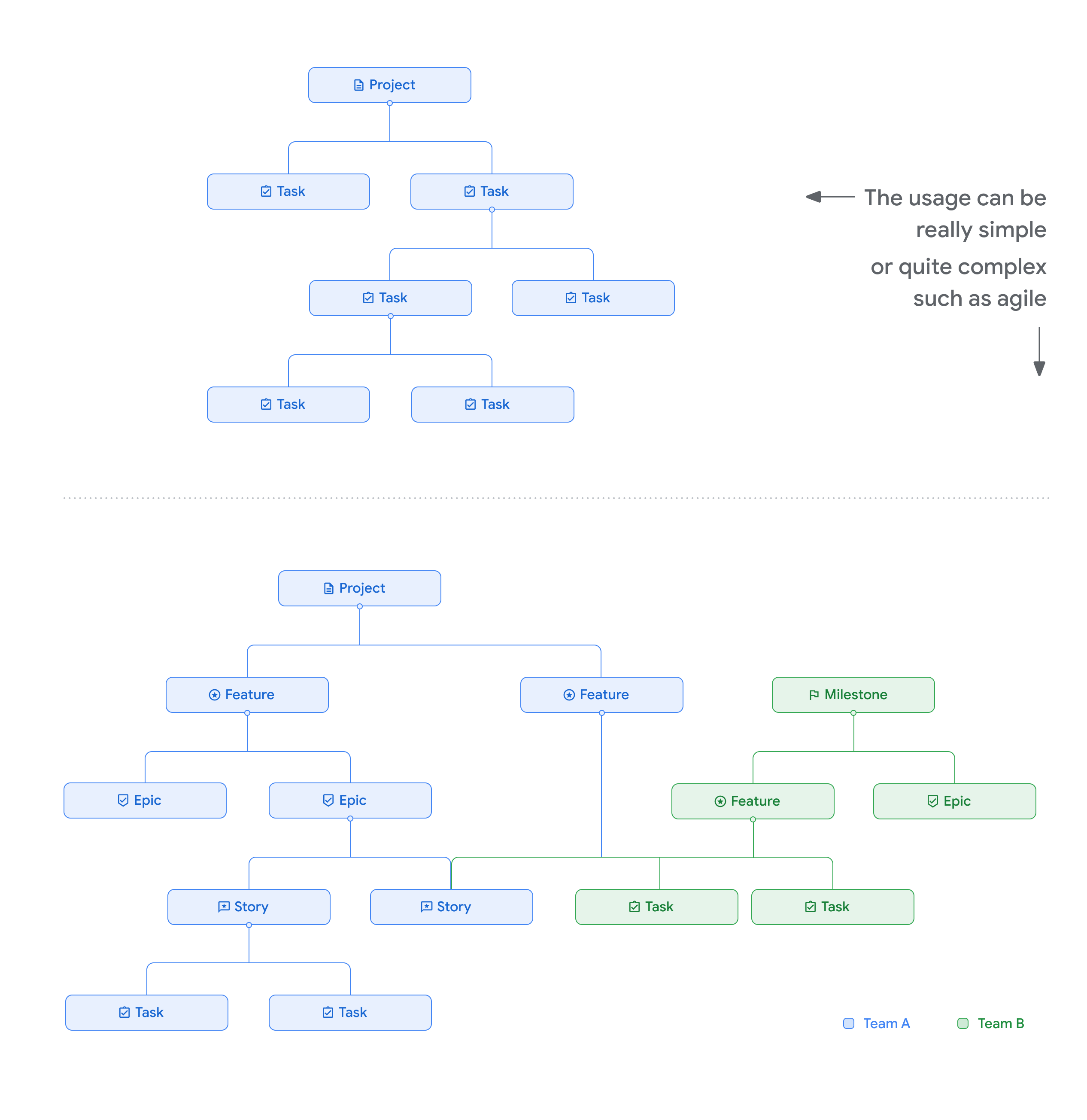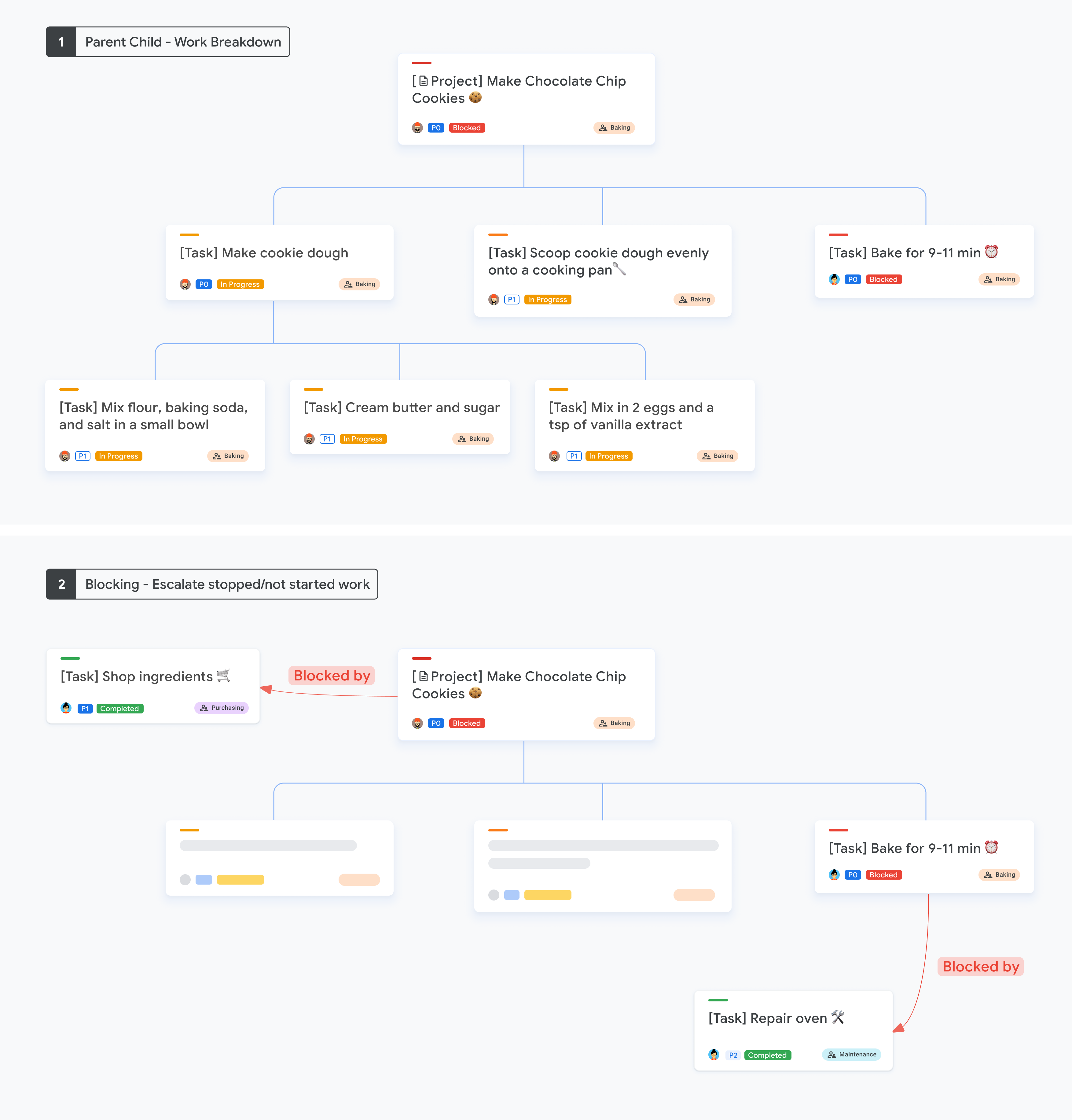روابط والدین و فرزندان، روابط والدین و فرزندان
با مجموعهها، منظم بمانید
ذخیره و طبقهبندی محتوا براساس اولویتهای شما.
Google Issue Tracker از روابط والدین و فرزند پشتیبانی می کند. رابطه والد-فرزند معمولاً برای نشان دادن شکست کار در یک تلاش معین استفاده می شود. یک والدین می توانند چند فرزند داشته باشند و یک فرزند می تواند چندین والدین داشته باشد.
رابطه والد و فرزند دارای ویژگی های زیر است:
| مشخصه | جزئیات |
|---|
| رابطه | ن:ن |
| سفارش دادن | سفارش فرزندان در یک والدین پشتیبانی می شود. |
| تشخیص چرخه | سیستم از وابستگی های چرخه ای جلوگیری می کند. |
| حداکثر کودکان مستقیم | 500 |
| حداکثر اجداد | 1000 |
نمونه ها
نمودار زیر چند نمونه از روابط والدین و فرزند را نشان می دهد.

روابط والدین و فرزند و مسدود کردن
وقتی از روابط والد-فرزند استفاده می کنید، روابط موجود Blocking و Blocked by هنوز پشتیبانی می شوند. هنگامی که روابط والدین و فرزند را با مسدود کردن ترکیب می کنید:
- از روابط والدین و فرزند برای تقسیم کار به واحدهای کوچکتر استفاده کنید.
- در مواقعی که زمانبندی و توالی حیاتی هستند از مسدود کردن و مسدود کردن استفاده کنید، و میخواهید نشانههای واضحی را در رابط کاربری ارائه دهید تا کار متوقف شده یا شروع نشده افزایش یابد.
نمودار زیر نمونه هایی از خرابی کار والدین-فرزند و مسدود کردن کار را نشان می دهد.

کلیه حقوق محفوظ است. Java علامت تجاری ثبتشده Oracle و/یا شرکتهای وابسته به آن است.
تاریخ آخرین بهروزرسانی 2025-07-24 بهوقت ساعت هماهنگ جهانی.
[null,null,["تاریخ آخرین بهروزرسانی 2025-07-24 بهوقت ساعت هماهنگ جهانی."],[[["\u003cp\u003eGoogle Issue Tracker enables the creation of parent-child relationships to represent the hierarchical breakdown of work within a project.\u003c/p\u003e\n"],["\u003cp\u003eIssues can have multiple parents and children, but the system prevents circular dependencies and limits the number of direct children to 500 and total ancestors to 1000.\u003c/p\u003e\n"],["\u003cp\u003eWhile parent-child relationships are ideal for structuring tasks, "Blocking" and "Blocked by" relationships should be used to indicate critical timing and sequencing dependencies.\u003c/p\u003e\n"],["\u003cp\u003eUsers are encouraged to leverage both relationship types to manage work effectively, using parent-child for work breakdown and blocking for highlighting time-sensitive dependencies.\u003c/p\u003e\n"]]],[],null,["# Parent-Child Relationships\n\nGoogle Issue Tracker supports parent-child relationships. A parent-child\nrelationship is typically used to represent the breakdown of work within a given\neffort. A parent can have multiple children, and a child can have multiple\nparents.\n\nThe parent-child relationship has the following characteristics:\n\n| Characteristic | Details |\n|-------------------------|----------------------------------------------------|\n| **Relationship** | N:N |\n| **Ordering** | Ordering of children within a parent is supported. |\n| **Cycle detection** | Cyclic dependencies are prevented by the system. |\n| **Max direct children** | 500 |\n| **Max ancestors** | 1000 |\n\nExamples\n--------\n\nThe following graphic shows some sample parent-child relationships.\n\nParent-child relationships and blocking\n---------------------------------------\n\nThe existing **Blocking** and **Blocked by** relationships are still supported\nwhen you use parent-child relationships. When you're combining parent-child\nrelationships with blocking:\n\n- Use **parent-child** relationships to break down work into smaller units.\n- Use **blocking** and **blocked by** when timing and sequence are critical, and you want to provide clear indications in the UI to escalate stopped or not started work.\n\nThe following graphic shows examples of parent-child and blocking work\nbreakdowns."]]
![]()
![]()
